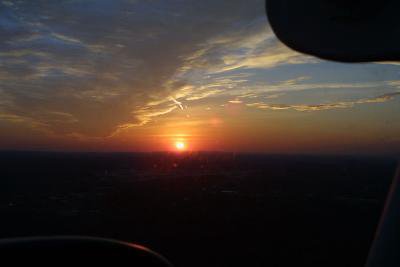March winds
The high from earning my multi-engine private last week was somewhat muted by being stuck on the ground for the following days.
Strong winds moved into the area last Thursday, gusting well into the 30s, and we had little choice but to wait them out. Problem is, they seemed to have their mind set on staying around here.
March winds were a little early this year and made for blustering conditions but I found solace in time spent with my wife and stepdaughter, Emily, who came to visit from Boston last week. We spent time at the air and space museum in Washington, D.C. on Thursday, where Emily and I took a fun ride in a full-motion F-18 simulator. Before we took our positions in the pod, she assigned me to flying the aircraft while she would destroy everything around us with missiles. I aknowledged her orders and prepared for the flight.
The ride was short, but exhilerating. We made low passes over tanks and war ships, played chicken with tracers and when all hell broke lose from Emily's precise and unrelenting gunmanship I'd apply full power and perform barrel rolls and loops to confuse the enemy.
She totally kicked their asses.
When Jen and Em left a couple of days later, I sadly remained grounded as the weather continued to play tricks on us.
Then came Monday and with it the enticing plan to fly IFR to Charlottesville, VA, Lynchburg, VA and Wilmington, NC, stop for food and return to Manassas at night. Route surveyed, kneeboard and approach plates neatly organized and flight plans filed: ready to go! I braved the cold winds to go and preflight the Seminole while Ron, my trusted instructor, enjoyed the heat of the terminal for just a few minutes longer. When he finally joined me on the ramp we hopped in, shut the door and ran through the start-up procedures.
The winds outside were howling at about 30 knots, but I didn't care and neither did Ron. We just wanted to go flying and in spite of the breeziness the sky was beautifully clear and inviting and conditions calmer at our various destinations.
After priming the left engine and pumping the throttle twice I hit the starter, eagerly awaiting it to cough and sputter to life. Nothing. Just the high-pitched sound of the starter spinning in vain. Dead.
Even after repositioning the prop nothing will do and even if it had, Ron noted he didn't want to get stuck in Wilmington.
He makes an escape plan so that we can secure the airplane as fast as possible and avoid the bone-chilling wind and minutes later we find ourselves brooding over the situation in the terminal, two very unhappy and frustrated pilots once again defeated in their plans to take to the skies.
This morning arrived and I awoke with low expectations. No way was I going to get all pumped up about going flying only to be disappointed again. Yet, when I caught a glimpse of the sky through the shades it appeared to be clear. Compelled by a rekindled optimism, I dashed outside to confirm what I had seen. Sure enough the sky was blue, peppered here and there by high cirrus clouds and the tree branches, hitherto battered by the wind, stood reasonably still in the chilly morning.
The weather held up and in fact got nicer as clouds to our west cleared as the day advanced. Hours later we were finally taxiing out to runway 34R for my first IFR flight here outside of the sim.
In mildly turbulent skies, we headed northwest to Winchester to shoot the ILS 32. The ATIS, however, noted that the glide slope was out of service so I quickly briefed the stepdowns and higher minimums for the localizer 32 and began the approach. In spite of a few bumps here and there it went well and since the good people at Potomac Approach declined our request for a full missed approach to the hold and back for a second flight in, I pointed the nose of our trusted craft toward Casanova VOR where we could begin the VOR A into Culpeper.
This approach went well too, although I lowered flaps to 25 degrees, which we don't do on a circling approach unless landing is assured. Spotted the airport at the missed approach point, circled to a left downwind for 22 and went missed. Climbed and turned left to 2,900 direct to CSN, entered the hold and shot the approach a second time, without a hitch, then back on the missed and re-entered the hold from where Ron called approach to get the ILS into KHEF or at least the GPS34R.
But again, our good friends at Potomac declined our request, in spite of light traffic, so Ron vectored me to a left base for 34R, where I made a nice landing as the sun began to set.
The flight was straightforward and while I didn't get to enjoy the view from up there (which Ron later informed me was spectacular) I had a blast. It was just nice to get off the ground and go fly around for a bit.
With any luck this clement weather will continue and we'll be able to go up every day from now on. Clouds and rain are supposed to roll in later this week but since they'll be bringing warmer temperatures with them I'm looking forward to some good actual time.


